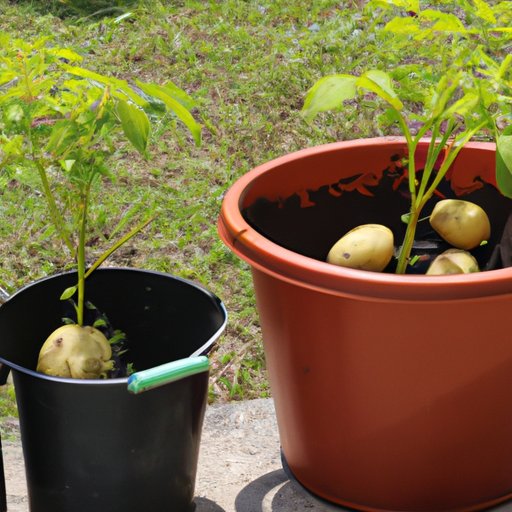
The Ultimate Guide to Growing Potatoes in a Bucket
Do you love the idea of growing your own vegetables but don’t have the space or resources for a traditional garden? Growing potatoes in a bucket may be the perfect solution for you! Not only is it an easy way to get started with gardening, but it can also be done virtually anywhere. In this guide, we’ll show you how to grow potatoes in a bucket step-by-step, how to build a bucket setup, which potato varieties to choose, and much more!
Step-by-Step Guide
The first step to growing potatoes in a bucket is to select the right type of soil. Ideally, you’ll want a loose, well-draining mix that is rich in organic matter. Once you’ve gathered your soil, it’s time to plant your seed potatoes in the bucket. Carefully place each seed potato into a small indentation in the soil, with the eyes facing up. Cover the potatoes with about four inches of soil.
Over the next few weeks, you’ll need to water your potatoes regularly and fertilize them as needed. As the plants grow taller, add more soil to the bucket to keep the potatoes covered. When you notice the plants starting to die back and yellow, it’s time to harvest your potatoes!
Benefits of Potato-Growing
Growing potatoes in a bucket comes with several benefits. First, it’s a great way for those without traditional garden space or resources to grow their own food. Additionally, growing in a bucket saves space, making it ideal for apartment dwellers. Finally, bucket-grown potatoes can be free from pests and diseases that may be present in garden soil.
DIY Bucket Setup
Building a potato-growing bucket is easier than you might think! All you’ll need is a 5-gallon bucket with drainage holes drilled into the bottom, a mix of loose and well-draining soil enriched with organic matter, and your seed potatoes.
Start by filling the bottom of the bucket with about four inches of soil. Next, make small indentations in the soil and place your seed potatoes, eyes facing up. Cover the potatoes with an additional four inches of soil. Gradually add more soil as the plants grow taller, always making sure the potatoes are covered. That’s it!
Tips for Harvest
Harvesting potatoes grown in a bucket is easy. When the plants start to die back and yellow, it’s a good indication that the potatoes are ready. To harvest, gently dig through the soil with your hands, feeling for the round tubers. Remove them from the soil one by one, taking care not to damage them.
After harvesting, it’s important to cure the potatoes by keeping them in a dry, dark place with a temperature between 45-60 degrees Fahrenheit for about two weeks. Once cured, store them in a cool, dark place that’s around 40-50 degrees Fahrenheit.
Best Potato Varieties
Not all potato varieties are created equal when it comes to growing in a bucket. Some varieties are better suited to container gardening than others. Here are a few of our favorites:
- Yukon Gold: This potato variety is highly productive and ideal for container gardening. It boasts a high yield and is great for mashing, baking, or roasting.
- Fingerling: These small, flavorful potatoes are perfect for growing in a bucket. They’re great boiled, steamed, or roasted.
- Red Pontiac: Another great variety for containers, Red Pontiac potatoes have thin skins and soft, white flesh. They’re delicious boiled, baked, or fried.
Troubleshooting Common Problems
If you’re experiencing problems with your potato plants, it could be due to under-watering or over-fertilizing. To combat under-watering, make sure to keep your soil consistently moist. Over-fertilization can cause scabbing on your potatoes, so be sure to fertilize them sparingly. Additionally, be on the lookout for pests such as aphids or potato beetles. Removing them by hand is the safest way to deal with an infestation.
Conclusion
While growing potatoes in a bucket may seem unconventional, it’s a highly effective way to produce your own food, even if you don’t have access to a traditional garden space.




